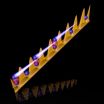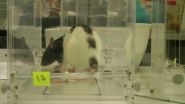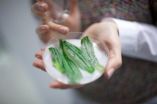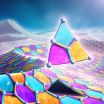(Press-News.org) This news release is available in German.
One of the most remarkable consequences of the rules in quantum mechanics is the capability of a quantum particle to penetrate through a potential barrier even though its energy would not allow for the corresponding classical trajectory. This is known as the quantum tunnel effect and manifests itself in a multitude of well-known phenomena. For example, it explains nuclear radioactive decay, fusion reactions in the interior of stars, and electron transport through quantum dots. Tunneling also is at the heart of many technical applications, for instance it allows for imaging of surfaces on the atomic length scale in scanning tunneling microscopes.
All the above systems have in common that they essentially represent the very fundamental paradigm of the tunnel effect: a single particle that penetrates through a single barrier. Now, the team of Hanns-Christoph Nägerl, Institute for Experimental Physics of the University of Innsbruck, Austria, has directly observed tunneling dynamics in a much more intriguing system: They see quantum particles transmitting through a whole series of up to five potential barriers under conditions where a single particle could not do the move. Instead the particles need to help each other via their strong mutual interactions and via an effect known as Bose enhancement.
In their experiment the scientists place a gas of Cesium atoms at extremely low temperatures just above absolute zero temperature into a potential landscape that is deliberately engineered by laser light. This so-called optical lattice forms a regular and perfect structure constituting the multiple tunneling barriers, similar to a washboard. As temperatures are so low and thus the atoms' kinetic energies are so tiny, the only way to move across the washboard is via tunneling through the barriers. The tunneling motion is initiated by applying a directed force onto the atoms along one of the lattice axes, that is, by tilting the washboard. It is now one of the crucial points in the experiment that the physicists control through how many barriers the particles penetrate by the interplay between the interaction and the strength of the force in conjunction with Bose enhancement as a result of the particles' quantum indistinguishability.
Very similar to a massive object moving in the earth's gravitational field, the tunneling atoms should loose potential energy when they move down the washboard. But where can they deposit this energy in such a perfect and frictionless environment? It's the interaction energy between the atoms when they share the same site of the lattice that compensates for the potential energy. As a result, the physicists found that the tunneling motion leads to discrete resonances corresponding to the number of barriers the particles penetrate through.
It is left for the future to explore the role of such long-range tunneling processes for lattice systems with ultracold atoms in the context of quantum simulation and quantum information processing, or for different physical settings, for instance electronic quantum devices, molecular or even biological systems.
INFORMATION: END
Long-range tunneling of quantum particles
2014-06-12
ELSE PRESS RELEASES FROM THIS DATE:
Vast genetic diversity among Mexicans found in large-scale study
2014-06-12
The first large-scale, comprehensive analysis of the genomic diversity of Mexico — led by researchers at the Stanford University School of Medicine, the University of California-San Francisco and the Mexican National Institute of Genomic Medicine — has identified a dazzling mosaic of genotypes and population substructures across the country.
Some groups are as genetically different from one another as Europeans are from East Asians.
The study, which will be published June 13 in Science, soundly refutes the current practice of lumping together Mexicans or Latinos as ...
Broad Institute, MGH researchers chart cellular complexity of brain tumors
2014-06-12
Scientists from the Broad Institute and Massachusetts General Hospital (MGH) have conducted a first-of-its-kind study that characterizes the cellular diversity within glioblastoma tumors from patients. The study, which looked at the expression of thousands of genes in individual cells from patient tumors, revealed that the cellular makeup of each tumor is more heterogeneous than previously suspected. The findings, which appear online in Science Express, will help guide future investigations into potential treatments for this devastating disease.
This is the first time ...
Mexican genetics study reveals huge variation in ancestry
2014-06-12
In the most comprehensive genetic study of the Mexican population to date, researchers from UC San Francisco and Stanford University, along with Mexico's National Institute of Genomic Medicine (INMEGEN), have identified tremendous genetic diversity, reflecting thousands of years of separation among local populations and shedding light on a range of confounding aspects of Latino health.
The study, which documented nearly 1 million genetic variants among more than 1,000 individuals, unveiled genetic differences as extensive as the variations between some Europeans and Asians, ...
Father's age influences rate of evolution
2014-06-12
The offspring of chimpanzees inherit 90% of new mutations from their father, and just 10% from their mother, a finding which demonstrates how mutation differs between humans and our closest living relatives, and emphasises the importance of father's age on evolution.
Published today in Science, researchers from the Wellcome Trust Centre for Human Genetics and the Biomedical Primate research Centre in the Netherlands looked at whether, in chimpanzees, there was a heightened risk of fathers passing on mutations to their children compared to humans.
In humans, each individual ...
New evidence for oceans of water deep in the Earth
2014-06-12
Researchers from Northwestern University and the University of New Mexico report evidence for potentially oceans worth of water deep beneath the United States. Though not in the familiar liquid form -- the ingredients for water are bound up in rock deep in the Earth's mantle -- the discovery may represent the planet's largest water reservoir.
The presence of liquid water on the surface is what makes our "blue planet" habitable, and scientists have long been trying to figure out just how much water may be cycling between Earth's surface and interior reservoirs through ...
With the right rehabilitation, paralyzed rats learn to grip again
2014-06-12
VIDEO:
This video depicts Restored grasping after immunotherapy and rehabilitative training.
Click here for more information.
Only if the timing, dosage and kind of rehabilitation are right can motor functions make an almost full recovery after a large stroke. Rats that were paralyzed down one side by a stroke almost managed to regain their motor functions fully if they were given the ideal combination of rehabilitative training and substances that boosted the growth of nerve fibers. ...
Unexpected origin for important parts of the nervous system
2014-06-12
A new study from Karolinska Institutet in Sweden shows that a part of the nervous system, the parasympathetic nervous system, is formed in a way that is different from what researchers previously believed. In this study, which is published in the journal Science, a new phenomenon is investigated within the field of developmental biology, and the findings may lead to new medical treatments for congenital disorders of the nervous system.
Almost all of the body's functions are controlled by the autonomous, involuntary nervous system, for example the heart and blood vessels, ...
Scientists discover link between climate change and ocean currents over 6 million years
2014-06-12
Scientists have discovered a relationship between climate change and ocean currents over the past six million years after analysing an area of the Atlantic near the Strait of Gibraltar, according to research published today (Friday, 13 June) in the journal Science.
An expedition of scientists, jointly led by Dr Javier Hernandez-Molina, from the Department of Earth Sciences at Royal Holloway, University of London, examined core samples from the seabed off the coast of Spain and Portugal which provided proof of shifts of climate change over millions of years.
The team ...
Habitat fragmentation increases vulnerability to disease in wild plants
2014-06-12
Proximity to other meadows increases disease resistance in wild meadow plants, according to a study led by Anna-Liisa Laine at the University of Helsinki. The results of the study, analysing the epidemiological dynamics of a fungal pathogen in the archipelago of Finland, will be published in Science on 13 June 2014.
The study surveyed more than 4,000 Plantago lanceolata meadows and their infection status by a powdery mildew fungus in the Åland archipelago of Finland. The surveys have continued since 2001, resulting in one of the world's largest databases on disease dynamics ...
Quantum computation: Fragile yet error-free
2014-06-12
This news release is available in German and Spanish. Even computers are error-prone. The slightest disturbances may alter saved information and falsify the results of calculations. To overcome these problems, computers use specific routines to continuously detect and correct errors. This also holds true for a future quantum computer, which will require procedures for error correction as well: "Quantum phenomena are extremely fragile and error-prone. Errors can spread rapidly and severely disturb the computer," says Thomas Monz, member of Rainer Blatt's research group ...





